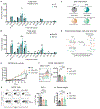The acid-sensing receptor GPR65 on tumor macrophages drives tumor growth in obesity
- PMID: 39423285
- PMCID: PMC12104511
- DOI: 10.1126/sciimmunol.adg6453
The acid-sensing receptor GPR65 on tumor macrophages drives tumor growth in obesity
Abstract
Multiple cancers, including colorectal cancer (CRC), are more frequent and often more aggressive in individuals with obesity. Here, we showed that macrophages accumulated within tumors of patients with obesity and CRC and in obese CRC mice and that they promoted accelerated tumor growth. These changes were initiated by oleic acid accumulation and subsequent tumor cell-derived acid production and were driven by macrophage signaling through the acid-sensing receptor GPR65. We found a similar role for GPR65 in hepatocellular carcinoma (HCC) in obese mice. Tumors in patients with obesity and CRC or HCC also exhibited increased GPR65 expression, suggesting that the mechanism revealed here may contribute to tumor growth in a range of obesity-associated cancers and represent a potential therapeutic target.
Conflict of interest statement
Competing Interests
The authors declare that they have no competing interests.
Figures






References
-
- Obesity and overweight (2021). https://www.who.int/news-room/fact-sheets/detail/obesity-and-overweight.
-
- Adult Obesity Facts (2022). https://www.cdc.gov/obesity/data/adult.html.
-
- Blüher M, Obesity: global epidemiology and pathogenesis. Nat Rev Endocrinol 15, 288–298 (2019). - PubMed
-
- Avgerinos KI, Spyrou N, Mantzoros CS, Dalamaga M, Obesity and cancer risk: Emerging biological mechanisms and perspectives. Metabolism 92, 121–135 (2019). - PubMed
Publication types
MeSH terms
Substances
Grants and funding
LinkOut - more resources
Full Text Sources
Medical
Molecular Biology Databases

